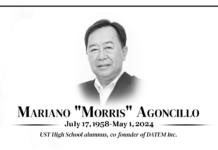TEN-YEAR-OLD Jason Tunay spent four years fighting cancer at the UST Hospital (USTH). Although he has conquered the dreaded disease, physicians in the hospital are still pushing for what they feel has been lacking for the last 15 years. But the “dream” will soon become a reality in the form of the USTH Benavides Cancer Institute.
“The University, as an institution, has to keep up with current developments. We should be able to offer oncological services to provide education, training, and to emphasize research on our trainees.” said Dr. Mateo Bagsic, administrative director of the USTH-Benavides Cancer Institute project.
Engr. Danilo Ferrer, the project manager of the Institute, said the Cancer Institute will complement Thomasian experts in surgical and medical oncology (the study of tumors). The proposed four-story building, covering 2,502 square meters in front of the USTH, will have facilities and provide services for both the research and the treatment of cancer.
Conceived in June 2004, the Cancer Institute is the first of four proposed institutes under a five-year strategic development plan to transform USTH into a globally competitive institution. The other three are the cardio-vascular, the endocrine, and the metabolic and organ transplant institutes.
USTH, known for its experts in oncology, has ample facilities except for radiotherapy, a treatment in which affected areas are exposed to gamma rays or X-rays, Bagsic said. As a result, cancer patients need to be brought back to other hospitals where radiotherapy units are available.
Once erected, the Institute will house specialized rooms such as the two latest models of Siemens Linear Accelerator (Linac) rooms for external beam radiation treatment. Linac will deliver uniform doses of high-energy x-rays to destroy cancer cells without damaging surrounding normal tissues.
A Brachytherapy room, where patients receive radiation therapy by orally ingesting radioactive substances to kill cancer cells at very close distances, will also be put up.
Other facilities—a mould room, dark room, consultation room, library, audio-visual room, auditorium, equipment bay, bed lift, recovery and holding bay, and a coffee shop—will also be available inside apart from a few wards, Ferrer said.
Best team
However, with state-of-the-art equipment, a team of experts will be needed to run the Benavides Cancer Institute. According to Ferrer, USTH has employed a radiation oncologist who will prescribe the needed treatment dosage, a medical physicist, and a dosimetrist who will regulate and calculate detailed treatment from the machines. In addition, a radiation therapist will accompany the patient throughout the treatment.
“This will be the first time various specialists, training programs, and research efforts will be directed in one roof, equipped with state-of-the-art technology, and endowed their own research facility,” hospital officials said.
On the other hand, a treatment planning team who will determine the tumor volume to be treated, specify the energy doses needed, arrange treatment fields, design beam-modifying devices, and calculate test results, will also be employed.
To protect therapists and other staff members from the rays emitted by Linacs, the Institute will also install treatment shielding, Ferrer said.
“We will provide adequate radiation shielding, (usually with lead or steel,) behind all junctions or pull boxes recessed in concrete walls,” Ferrer said.
There will also be experts who will assess requirements and limits of the Linacs and Brachytheraphy procedures, and verify the thickness and location of radiation shielding.
Safety device systems, such as switches and common red warning lights in hospitals, will be provided to indicate conditions of radioactive facilities. Experts will be tasked to disable Linac operations from the outside when required, and secure doors during Linac operations. Also, devices that will detect the presence of radiation that remains will also be installed.
Dealing with cancer does not only involve treatment and diagnosis but prevention too, Bagsic said.
“We will have a holistic approach to educate the general public, perform early diagnosis, and perform the multi-disciplinarian approach to patients,” Bagsic said. There will also be support groups for those suffering from cancer, to educate them on how to cope with their disease and accept the implications, Bagsic added.
The transformation of the USTH can be traced back to 1942, when its Charity Division was opened at the UST High School Building while its Pay Division is on its present site, which is the former Education Building. Twenty-three years later, the Clinical Division on Forbes St. (A. H. Lacson Ave.) was also erected. It was from these humble beginnings that opened opportunities for better projects for the medical services of the University hospital.
The cancer institute is now under construction and is expected to be fully operational by March 7 next year, in time for the 60th anniversary of the hospital. By then, USTH will hopefully become a catalyst in the ardous battle against cancer.













